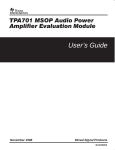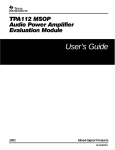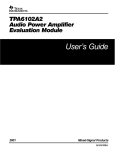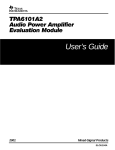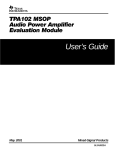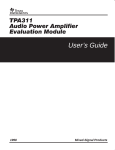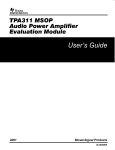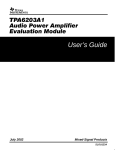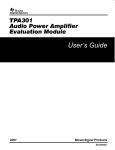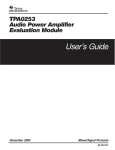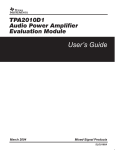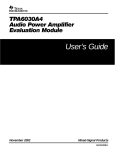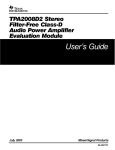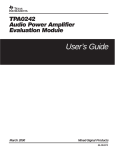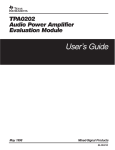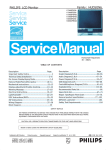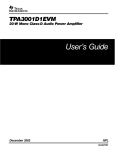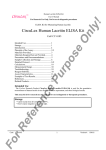Download Texas Instruments TPA6110A2 MSOP User's Manual
Transcript
User’s Guide 2000 Mixed-Signal Products SLOU085 IMPORTANT NOTICE Texas Instruments and its subsidiaries (TI) reserve the right to make changes to their products or to discontinue any product or service without notice, and advise customers to obtain the latest version of relevant information to verify, before placing orders, that information being relied on is current and complete. All products are sold subject to the terms and conditions of sale supplied at the time of order acknowledgment, including those pertaining to warranty, patent infringement, and limitation of liability. TI warrants performance of its semiconductor products to the specifications applicable at the time of sale in accordance with TI’s standard warranty. Testing and other quality control techniques are utilized to the extent TI deems necessary to support this warranty. Specific testing of all parameters of each device is not necessarily performed, except those mandated by government requirements. Customers are responsible for their applications using TI components. In order to minimize risks associated with the customer’s applications, adequate design and operating safeguards must be provided by the customer to minimize inherent or procedural hazards. TI assumes no liability for applications assistance or customer product design. TI does not warrant or represent that any license, either express or implied, is granted under any patent right, copyright, mask work right, or other intellectual property right of TI covering or relating to any combination, machine, or process in which such semiconductor products or services might be or are used. TI’s publication of information regarding any third party’s products or services does not constitute TI’s approval, warranty or endorsement thereof. Copyright 2000, Texas Instruments Incorporated Information About Cautions and Warnings Preface Read This First Information About Cautions and Warnings This book may contain cautions and warnings. This is an example of a caution statement. A caution statement describes a situation that could potentially damage your software or equipment. This is an example of a warning statement. A warning statement describes a situation that could potentially cause harm to you. The information in a caution or a warning is provided for your protection. Please read each caution and warning carefully. Related Documentation From Texas Instruments TI Plug-N-Play Audio Amplifier Evaluation Platform (literature number SLOU011) provides detailed information on the evaluation platform and its use with TI audio evaluation modules. TPA6110A2 150-mW Stereo Audio Power Amplifier (literature number SLOS314) This is the data sheet for the TPA6110A2 audio amplifier integrated circuit. Read This First iii Running Title—Attribute Reference FCC Warning This equipment is intended for use in a laboratory test environment only. It generates, uses, and can radiate radio frequency energy and has not been tested for compliance with the limits of computing devices pursuant to subpart J of part 15 of FCC rules, which are designed to provide reasonable protection against radio frequency interference. Operation of this equipment in other environments may cause interference with radio communications, in which case the user at his own expense will be required to take whatever measures may be required to correct this interference. iv Running Title—Attribute Reference Contents 1 Introduction . . . . . . . . . . . . . . . . . . . . . . . . . . . . . . . . . . . . . . . . . . . . . . . . . . . . . . . . . . . . . . . . . . . . . 1.1 Features . . . . . . . . . . . . . . . . . . . . . . . . . . . . . . . . . . . . . . . . . . . . . . . . . . . . . . . . . . . . . . . . . . 1.2 Description . . . . . . . . . . . . . . . . . . . . . . . . . . . . . . . . . . . . . . . . . . . . . . . . . . . . . . . . . . . . . . . . 1.3 TPA6110A2 MSOP EVM Specifications . . . . . . . . . . . . . . . . . . . . . . . . . . . . . . . . . . . . . . . . 1-1 1-2 1-3 1-3 2 Operation . . . . . . . . . . . . . . . . . . . . . . . . . . . . . . . . . . . . . . . . . . . . . . . . . . . . . . . . . . . . . . . . . . . . . . . 2.1 Precautions . . . . . . . . . . . . . . . . . . . . . . . . . . . . . . . . . . . . . . . . . . . . . . . . . . . . . . . . . . . . . . . . 2.2 Quick Start List for Platform . . . . . . . . . . . . . . . . . . . . . . . . . . . . . . . . . . . . . . . . . . . . . . . . . . 2.3 Quick Start List for Stand-Alone . . . . . . . . . . . . . . . . . . . . . . . . . . . . . . . . . . . . . . . . . . . . . . 2.4 References . . . . . . . . . . . . . . . . . . . . . . . . . . . . . . . . . . . . . . . . . . . . . . . . . . . . . . . . . . . . . . . . 2.4.1 TPA6110A2 MSOP EVM Connected as a Stereo Headphone Amplifier . . . . . 2.4.2 TPA6110A2 MSOP EVM Schematic Diagram . . . . . . . . . . . . . . . . . . . . . . . . . . . 2.4.3 TPA6110A2 MSOP Audio Power Amplifier Evaluation Module Parts List . . . . 2.4.4 TPA6110A2 EVM PCB Layers . . . . . . . . . . . . . . . . . . . . . . . . . . . . . . . . . . . . . . . . 2-1 2-2 2-3 2-4 2-5 2-5 2-5 2-6 2-6 Figures 1–1 2–1 2–2 2–3 2–4 2–5 2–6 2–7 2–8 The TI TPA6110A2 Audio Amplifier Evaluation Module . . . . . . . . . . . . . . . . . . . . . . . . . . . . . Quick Start Platform Map . . . . . . . . . . . . . . . . . . . . . . . . . . . . . . . . . . . . . . . . . . . . . . . . . . . . . . Quick Start Module Map . . . . . . . . . . . . . . . . . . . . . . . . . . . . . . . . . . . . . . . . . . . . . . . . . . . . . . . TPA6110A2 MSOP EVM Connected as a Stereo Headphone Amplifier . . . . . . . . . . . . . . . TPA6110A2 MSOP EVM Schematic Diagram . . . . . . . . . . . . . . . . . . . . . . . . . . . . . . . . . . . . . TPA6110A2 EVM PCB Layers . . . . . . . . . . . . . . . . . . . . . . . . . . . . . . . . . . . . . . . . . . . . . . . . . . TPA6110A2 EVM Silkscreen . . . . . . . . . . . . . . . . . . . . . . . . . . . . . . . . . . . . . . . . . . . . . . . . . . . . TPA6110A2 EVM PCB Top Layer . . . . . . . . . . . . . . . . . . . . . . . . . . . . . . . . . . . . . . . . . . . . . . . TPA6110A2 EVM PCB Bottom Layer . . . . . . . . . . . . . . . . . . . . . . . . . . . . . . . . . . . . . . . . . . . . 1-3 2-2 2-4 2-5 2-5 2-6 2-7 2-7 2-7 Tables 2–1 2–2 2–3 Typical TI Plug-N-Play Platform Jumper and Switch Settings for the TPA6110A2 MSOP EVM . . . . . . . . . . . . . . . . . . . . . . . . . . . . . . . . . . . . . . . . . . . . . . . . . . . . . . . 2-1 Platform Jumper and Switch Settings for the TPA6110A2 MSOP EVM . . . . . . . . . . . . . . . 2-3 TPA6110A2 MSOP EVM Parts List . . . . . . . . . . . . . . . . . . . . . . . . . . . . . . . . . . . . . . . . . . . . . . 2-6 Contents v vi Chapter 1 Introduction This chapter provides an overview of the Texas Instruments (TI) TPA6110A2 MSOP audio amplifier evaluation module (SLOP338). It includes a list of EVM features, a brief description of the module illustrated with a pictorial diagram, and a list of EVM specifications. Topic Page 1.1 Features . . . . . . . . . . . . . . . . . . . . . . . . . . . . . . . . . . . . . . . . . . . . . . . 1–2 1.2 Description . . . . . . . . . . . . . . . . . . . . . . . . . . . . . . . . . . . . . . . . . . . . . . . . . . . 1–3 1.3 TPA6110A2 MSOP EVM Specifications . . . . . . . . . . . . . . . . . . . . . . . . . . 1–3 1-1 Features 1.1 Features The TI TPA6110A2 MSOP audio amplifier evaluation module and the TI plug-n-play audio amplifier evaluation platform include the following features: TPA6110A2 MSOP Stereo Audio Power Amplifier Evaluation Module Dual channel, single-ended operation 150-mW output power into 8 Ω at 5 V 2.5-V to 5.5-V operation Very low distortion: THD+N is less than 0.01% at 1 kHz and less than 0.03% from 20 Hz to 20 kHz into 10-kΩ loads Less than 0.02% at 1 kHz and less than 0.4% from 20 Hz to 20 kHz into 32-Ω loads Less than 0.05% at 1 kHz and less than 0.8% from 20 Hz to 20 kHz into 8-Ω loads Extremely low current consumption in shutdown mode Internal thermal and short-circuit protection Internal pop reduction circuitry Quick and Easy Configuration With the TI Plug-N-Play Audio Amplifier Evaluation Platform Evaluation module is designed to simply plug into the platform, automatically making all signal, control, and power connections Platform provides flexible power options Jumpers on the platform select power and module control options Switches on the platform route signals Platform provides quick and easy audio input and output connections Platform Power Options Onboard 9-V battery External 5-V–15-V (VCC) supply inputs External regulated VDD supply input Socket for on-board 5-V VDD voltage regulator EVM Onboard overvoltage and reverse polarity power protection Platform Audio Input and Output Connections 1-2 Left and right RCA phono jack inputs Miniature stereo phone jack input Left and right RCA phono jack outputs Left and right compression speaker terminal outputs Miniature stereo headphone jack output Introduction Description 1.2 Description The TPA6110A2 MSOP audio power amplifier evaluation module is a complete, low-power stereo audio power amplifier for high-fidelity line-level output, headphone, and small speaker applications. It consists of the TI TPA6110A2 150-mW stereo audio power amplifier IC in a very small MSOP package, along with a small number of other parts mounted on a circuit board that is approximately one and a quarter inches square (Figure 1–1). Figure 1–1. The TI TPA6110A2 Audio Amplifier Evaluation Module VDD GND Shutdown S1 IN1 R1 GND C3 C5 R2 R5 C1 U1 Vo1 GND C4 C2 R3 R4 TEXAS INSTRUMENTS IN2 GND SLOP338 TPA6110A2 MSOP EVM GND Vo2 † Due to the very small size of the MSOP IC package, the standard part number TPA6110A2 is replaced with the code TIAIZ. Single in-line header pins are mounted to the underside of the module circuit board; these pins allow the EVM to be plugged into the TI plug-n-play audio amplifier evaluation platform, or to be wired directly into existing circuits and equipment when used stand-alone. The platform has room for a single TPA6110A2 evaluation module and is a convenient vehicle for demonstrating TI’s audio power amplifier and related evaluation modules. The EVMs simply plug into the platform, which automatically provides power to the modules, interconnects them correctly, and connects them to a versatile array of standard audio input and output jacks and connectors. Easy-to-use configuration controls allow the platform and EVMs to quickly model many possible end-equipment configurations. There is nothing to build, nothing to solder, and nothing but the speakers included with the platform to hook up. 1.3 TPA6110A2 MSOP EVM Specifications Supply voltage range, VDD . . . . . . . . . . . . . . . . . . . . . . . . . . . . . . . . . . . . . . . . . . . . . . 2.5 V to 5.5 V Supply current, IDD . . . . . . . . . . . . . . . . . . . . . . . . . . . . . . . . . . . . . . . . . . . . . . . . . . . . . 160 mA, max Continuous output power, PO: 8 Ω, VDD = 5 V . . . . . . . . . . . . . . . . . . . . . . . . . . . . . . . . . . . 150 mW Audio input voltage, VI . . . . . . . . . . . . . . . . . . . . . . . . . . . . . . . . . . . . . . . . . . . . VDD + 0.3 Vpp, max Minimum load impedance, RL . . . . . . . . . . . . . . . . . . . . . . . . . . . . . . . . . . . . . . . . . . . . . . . . . . . . 8 Ω Introduction 1-3 1-4 Introduction Chapter 2 Operation Follow the steps in this chapter to quickly prepare the TPA6110A2 MSOP audio amplifier EVM for use. The TPA6110A2 MSOP EVM and the TI plug-n-play audio amplifier evaluation platform provide a quick and easy way to connect power, signal and control inputs, and signal outputs to the EVM using standard connectors. However, the audio amplifier evaluation module can be used stand-alone by making connections directly to the module pins and can be wired directly into existing circuits or equipment. The platform switch and jumper settings shown in Table 2–1 are typical for the TPA6110A2 MSOP EVM and will cause the TPA6110A2 IC to shutdown/mute when a plug is removed from platform headphone jack J10. Table 2–1. Typical TI Plug-N-Play Platform Jumper and Switch Settings for the TPA6110A2 MSOP EVM EVM JP6 JP7 JP8 S2 S3 TPA6110A2 X Lo X See Note 2 U5 Notes: 1) X = Don’t care 2) Set S2 to ON when signal conditioning board is installed in U1; set S2 to OFF when no signal conditioning board is installed. Topic Page 2.1 Precautions . . . . . . . . . . . . . . . . . . . . . . . . . . . . . . . . . . . . . . . . . . . . . . . . . . 2–2 2.2 Quick Start List for Platform . . . . . . . . . . . . . . . . . . . . . . . . . . . . . . . . . . . 2–3 2.3 Quick Start List for Stand-Alone . . . . . . . . . . . . . . . . . . . . . . . . . . . . . . . . 2–4 2.4 References . . . . . . . . . . . . . . . . . . . . . . . . . . . . . . . . . . . . . . . . . . . . . . . . . . . 2–5 Operation 2-1 Precautions 2.1 Precautions Power Supply Input Polarity and Maximum Voltage Always ensure that the polarity and voltage of the external power connected to VCC power input connector J1, J2, and/or VDD power input connector J6 are correct. Overvoltage or reverse-polarity power applied to these terminals can open onboard soldered-in fuses and cause other damage to the platform, installed evaluation modules, and/or the power source. Inserting or Removing EVM Boards Do not insert or remove EVM boards with power applied—damage to the EVM board, the platform, or both may result. Figure 2–1. Quick Start Platform Map 1 10 6b C1+ On Off JP3 ICC VR2 JP4 VR1 F2 U6 + LED2 VDD U2 U1 Left Out J5 Left In Stereo Headphone 9 Output HP Out J10 5 Left Out 2 + R4 J9 + S3 HP Source GND R3 – Hi Spk(U2-U4) C3 C2 JP8 U5 U5 JP7 HP(U5) U2-U4 Polarity Lo TP1 TEXAS INSTRUMENTS 1997 3 Mode Mute JP6 U4 ****CAUTION**** Do not insert or remove EVM boards with power applied Plug-N-Play Audio Amplifier Evaluation Platform SLOP097 Rev. C.1 Speaker Output + On Conditioning 8 + Right – Out U3 Off S2 J4 Stereo In Audio Input 6a J8 J7 Right Out JP5 IDD LED1 VCC Audio Power Amps DC Power In/Out J6 VDD In/Out D1 D2 D3 J3 Right In R2 R1 Signal Conditioning 2-2 POWER B1 SUPPLY S1 Pwr Batt J1 D4 J2 AC/DC In 6b JP2 AC/DC (J2) JP1 VCC(J1) DC SOURCE VCC In + Power Input F1 7b 6b R5 4 Operation Quick Start List for Platform 2.2 Quick Start List for Platform Follow these steps when using the TPA6110A2 MSOP EVM with the TI plug-n-play audio amplifier evaluation platform (see the platform user’s guide, SLOU011, for additional details). Numbered callouts for selected steps are shown in Figure 2–1. Platform preparations 1) Ensure that all external power sources are set to off and that the platform power switch S1 is set to off. 2) Install a TPA6110A2 MSOP module in platform socket U5, taking care to align the module pins correctly. 3) Use switch S2 to select or bypass the signal conditioning EVM (U1) 4) Set control signal polarity jumper JP7 to Lo. 5) Set HP source switch S3 to U5 to route the output signal to the headphone jack (J10). Table 2–2. Platform Jumper and Switch Settings for the TPA6110A2 MSOP EVM EVM JP6 JP7 JP8 S2 S3 TPA6110A2 X Lo X See Note 2 U5 Notes: 1) X = Don’t care 2) Set S2 to ON when signal conditioning board is installed in U1; set S2 to OFF when no signal conditioning board is installed. Power supply 6) Select and connect the power supply: a) Connect an external regulated power supply set to a voltage between 2.5 V and 5.5 V to platform VDD power input connector J6, taking care to observe marked polarity, or b) Install 3-V to 5-V voltage regulator EVM (SLVP097 or equiv.) in platform socket U6. Install a 9-V battery in B1 or connect a 7 V – 12 V power source to a platform VCC power input J1 or J2 and jumper the appropriate power input (see platform user’s guide). Inputs and outputs 7) Ensure that signal source level is set to minimum. 8) Connect the audio source to left and right RCA phono jacks J3 and J5 or stereo miniature phone jack J4. 9) Connect 32-Ω headphones to headphone jack J10. Power-up 10) Verify correct voltage and input polarity and set the external power supply to ON. If VCC and an onboard regulator EVM are used to provide VDD, set platform power switch S1 to ON. Platform LED2 lights indicating the presence of VDD, and the evaluation modules installed on the platform begin operation. 11) Adjust the signal source level as needed. Operation 2-3 Quick Start List for Stand-Alone 2.3 Quick Start List for Stand-Alone Follow these steps to use the TPA6110A2 MSOP EVM stand-alone or when connecting it to existing circuits or equipment. Connections to the TPA6110A2 MSOP module header pins can be made via individual sockets, wire-wrapping, or soldering to the pins, either on the top or the bottom of the module circuit board. Numbered callouts for selected steps are shown in Figure 2–2 and details appear in Chapter 3. Figure 2–2. Quick Start Module Map 2 VDD GND Shutdown S1 5 4 IN1 R1 GND C3 C5 R2 R5 C1 U1 Vo1 GND 6 GND Vo2 6 C4 C2 R3 R4 TEXAS INSTRUMENTS 4 IN2 GND SLOP338 TPA6110A2 MSOP EVM † Due to the very small size of the MSOP IC package, the standard part number TPA6110A2 is replaced with the code TIAIZ. Power supply 1) Ensure that all external power sources are set to off. 2) Connect an external regulated power supply set to 5 V to the module VDD and GND pins, taking care to observe marked polarity. Inputs and outputs 3) Ensure that the signal source level is set to minimum. 4) Connect the audio source to the module IN1, IN2, and GND pins, taking care to observe marked polarity. 5) Connect the shutdown (S1) pin to VDD through a normally open switch. 6) Connect 32-Ω headphones to the module VO1, and VO2 pins through 33 µF to 1000 µF output-coupling capacitors (see Figure 2– 3) and return to the GND pin, or 7) For line output, connections to the VO1 and VO2 pins must be made through 33 µF to 1000 µF output-coupling capacitors and returned to GND. Power-up 8) Verify correct voltage and input polarity and set the external power supply to ON. The EVM should begin operation. 9) Adjust the signal source level as needed. 2-4 Operation References 2.4 References 2.4.1 TPA6110A2 MSOP EVM Connected as a Stereo Headphone Amplifier Figure 2–3. TPA6110A2 MSOP EVM Connected as a Stereo Headphone Amplifier 5 VDC Shutdown GND VDD Shutdown NO S1 Audio Input (Right) IN1 R1 GND C5 R2 C3 R5 C1 U1 Vo1 GND + C4 C2 R3 R4 TEXAS INSTRUMENTS Audio Input (Left) IN2 GND 33 µF – 1000 µF SLOP338 TPA6110A2 MSOP EVM GND Vo2 + 33 µF – 1000 µF † Due to the very small size of the MSOP IC package, the standard part number TPA6110A2 is replaced with the code TIAIZ. 2.4.2 TPA6110A2 MSOP EVM Schematic Diagram Figure 2–4. TPA6110A2 MSOP EVM Schematic Diagram Audio Input 1 R2 20 kΩ C3 1 µF 1 IN 1 C1 1 µF S1 2 VDD Shutdown (VDD to Shutdown) 8 Bypass Vo1 7 R5 82 kΩ Vo1 GND TPA6110A2 MSOP SHUTDOWN 3 Shutdown VDD 6 C4 1 µF C5 10 µF + R1 82 kΩ C2 1 µF R3 20 kΩ VDD 2 to 5.5 V GND 4 IN 2 Vo2 5 Vo2 Audio Input 2 R4, 82 kΩ Operation 2-5 TPA6110A2 MSOP Audio Power Amplifier Evaluation Module Parts List 2.4.3 TPA6110A2 MSOP Audio Power Amplifier Evaluation Module Parts List Table 2–3. TPA6110A2 MSOP EVM Parts List Ref. Description Size Qty. Manufacturer/ Part Number Vendor/Number R2, R3 Resistor, 20 kΩ, 1/16 W, 5%, SMD 0603 3 Panasonic ERJ-3GSYJ203 Digi-Key P20PGCT–ND R1, R4, R5 Resistor, 82 kΩ, 1/16 W, 5%, SMD 0603 2 Panasonic ERJ-3GSYJ823 Digi-Key P82KGCT–ND C1–C4 Capacitor, 1 µF, +20/–80%, Non-polarized, SMD 0603 4 Murata GRM39-Y5V105Z10 Newark C5 Capacitor, 10 µF, 6.3 V, SMD A 1 Panasonic ECS-TOJY106R Digi-Key PCS1106CT-ND S1 (SHUTDOWN) Switch, momentary SMD 1 Panasonic P8048SCT-ND Digi-Key P8048SCT-ND U1 IC, TPA6110A2, APA, 150 mW, 2 channel 1 TI TPA6110A2DGN PNP Pins Terminal post headers 11 Sullins MSOP-8 Digi-Key S1022-36-ND The following illustrations depict the TPA6110A2 EVM PCB layers and silkscreen. These drawings are not to scale. Gerber plots can be obtained from any TI sales office. 2.4.4 TPA6110A2 EVM PCB Layers Figure 2–5. TPA6110A2 EVM PCB Layers 2-6 Operation TPA6110A2 EVM PCB Layers Figure 2–6. TPA6110A2 EVM Silkscreen Figure 2–7. TPA6110A2 EVM PCB Top Layer Figure 2–8. TPA6110A2 EVM PCB Bottom Layer Operation 2-7 2-8 Operation


















